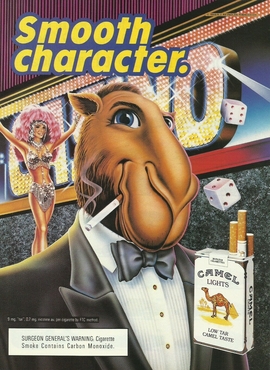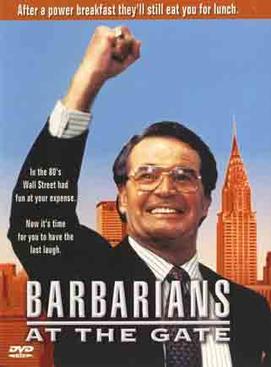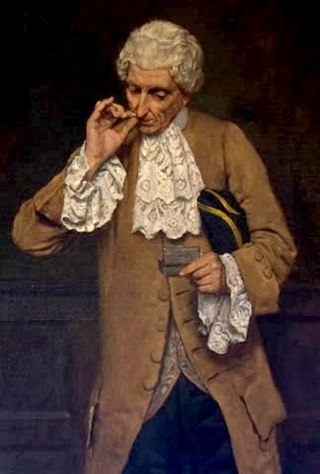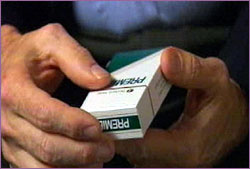
A cigarette is a narrow cylinder containing a combustible material, typically tobacco, that is rolled into thin paper for smoking. The cigarette is ignited at one end, causing it to smolder; the resulting smoke is orally inhaled via the opposite end. Cigarette smoking is the most common method of tobacco consumption. The term cigarette, as commonly used, refers to a tobacco cigarette, but the word is sometimes used to refer to other substances, such as a cannabis cigarette or an herbal cigarette. A cigarette is distinguished from a cigar by its usually smaller size, use of processed leaf, and paper wrapping, which is typically white. Since the 1920s, cigarettes have been a major source of advertising revenue for the media, of traffic for small stores, and of tax revenue for governments.

The R. J. Reynolds Tobacco Company (RJR) is an American tobacco manufacturing company based in Winston-Salem, North Carolina, and headquartered at the RJR Plaza Building. Founded by R. J. Reynolds in 1875, it is the second-largest tobacco company in the United States. The company is a wholly owned subsidiary of Reynolds American, after merging with the U.S. operations of British American Tobacco in 2004.

Joe Camel was an advertising mascot used by the R. J. Reynolds Tobacco Company (RJR) for their cigarette brand Camel. The character was created in 1974 for a French advertising campaign, and was redesigned for the American market in 1988. He appeared in magazine advertisements, clothing, and billboards among other print media and merchandise.

R. J. Reynolds Nabisco, Inc., is a defunct American conglomerate, selling tobacco and food products, headquartered in the Calyon Building in Midtown Manhattan, New York City. R. J. Reynolds Nabisco stopped operating as a single entity in 1999; however, both RJR and Nabisco still exist.

Snus is a tobacco product, originating from a variant of dry snuff in early 18th-century Sweden. It is placed between the upper lip and gum for extended periods, as a form of sublabial administration. Snus is not fermented. Although used similarly to American dipping tobacco, snus does not typically result in the need for spitting and, unlike naswar, snus is steam-pasteurized.
Virginia Slims is an American brand of cigarettes owned by Altria. It is manufactured by Philip Morris USA and Philip Morris International.

Barbarians at the Gate is a 1993 American biographical comedy-drama television film directed by Glenn Jordan and written by Larry Gelbart, based on the 1989 book of the same name by Bryan Burrough and John Helyar. The film stars James Garner, Jonathan Pryce, and Peter Riegert. It tells the true story of F. Ross Johnson, who was the president and CEO of RJR Nabisco.

Nicotine marketing is the marketing of nicotine-containing products or use. Traditionally, the tobacco industry markets cigarette smoking, but it is increasingly marketing other products, such as electronic cigarettes and heated tobacco products. Products are marketed through social media, stealth marketing, mass media, and sponsorship. Expenditures on nicotine marketing are in the tens of billions a year; in the US alone, spending was over US$1 million per hour in 2016; in 2003, per-capita marketing spending was $290 per adult smoker, or $45 per inhabitant. Nicotine marketing is increasingly regulated; some forms of nicotine advertising are banned in many countries. The World Health Organization recommends a complete tobacco advertising ban.

Smokeless tobacco is a tobacco product that is used by means other than smoking. Their use involves chewing, sniffing, or placing the product between gum and the cheek or lip. Smokeless tobacco products are produced in various forms, such as chewing tobacco, snuff, snus, and dissolvable tobacco products. Smokeless tobacco products typically contain over 3000 constituents. All smokeless tobacco products contain nicotine and are therefore highly addictive. Quitting smokeless tobacco use is as challenging as smoking cessation.

A menthol cigarette is a cigarette flavored with the compound menthol.
Tobacco harm reduction (THR) is a public health strategy to lower the health risks to individuals and wider society associated with using tobacco products. It is an example of the concept of harm reduction, a strategy for dealing with the use of drugs. Tobacco smoking is widely acknowledged as a leading cause of illness and death, and reducing smoking is vital to public health.

An electronic cigarette is a device that simulates tobacco smoking. It consists of an atomizer, a power source such as a battery, and a container such as a cartridge or tank. Instead of smoke, the user inhales vapor. As such, using an e-cigarette is often called "vaping". The atomizer is a heating element that vaporizes a liquid solution called e-liquid, which quickly cools into an aerosol of tiny droplets, vapor and air. E-cigarettes are activated by taking a puff or pressing a button. Some look like traditional cigarettes, and most kinds are reusable. The vapor mainly comprises propylene glycol and/or glycerin, usually with nicotine and flavoring. Its exact composition varies, and depends on several things including user behavior.

Flavored tobacco products — tobacco products with added flavorings — include types of cigarettes, cigarillos and cigars, hookahs and hookah tobacco, various types of smokeless tobacco, and more recently electronic cigarettes. Flavored tobacco products are especially popular with youth and have therefore become targets of regulation in several countries.

Ventilated cigarettes are considered to have a milder flavor than regular cigarettes. These cigarette brands may be listed as having lower levels of tar ("low-tar"), nicotine, or other chemicals as "inhaled" by a "smoking machine". However, the scientific evidence is that switching from regular to light or low-tar cigarettes does not reduce the health risks of smoking or lower the smoker's exposure to the nicotine, tar, and carcinogens present in cigarette smoke.
Dissolvable tobacco is a tobacco product that dissolves in the mouth. Major tobacco manufacturers that sell dissolvable tobacco products include R. J. Reynolds Tobacco Company. Research into health effects of dissolvable and other new tobacco products was among the reasons of the establishment of the Tobacco Products Scientific Advisory Committee of the Food and Drug Administration in 2009.

blu is an electronic cigarette brand, produced by Fontem Ventures and owned by Imperial Brands. The brand blu sells various types of rechargeable and disposable e-cigarettes with a wide selection of flavored and unflavored liquids. Its products are available in many countries and each market offers different types of products suited to public demand and opportunities. The global headquarters of blu is located in Amsterdam. Local offices are active around the world to service all markets which sell the brand.
A heated tobacco product (HTP) is a tobacco product that heats the tobacco at a lower temperature than conventional cigarettes. These products contain nicotine, which is a highly addictive chemical. The heat generates an aerosol or smoke to be inhaled from the tobacco, which contains nicotine and other chemicals. HTPs may also contain additives not found in tobacco, including flavoring chemicals. HTPs generally heat tobacco to temperatures under 600 °C (1100 °F), a lower temperature than conventional cigarettes.
The composition of the emissions generated from heated tobacco products are generally lower than that found in cigarette smoke. This is due to the comparatively low temperatures, the filter systems, and physical design. The composition of what is produced is complex. The main toxicants found in the emissions of cigarette smoke are also found in the emissions of these products in varying concentrations. The aerosol generated contains levels of nicotine and cancer-causing chemicals that are comparable to regular cigarettes. The emissions contained 84% of the nicotine found in regular cigarettes.
Electronic cigarettes are marketed to smoking and non-smoking men, women, and children as being safer than cigarettes. E-cigarette businesses have considerably accelerated their marketing spending. All of the large tobacco businesses are engaging in the marketing of e-cigarettes. For the majority of the large tobacco businesses these products are quickly becoming a substantial part of the total advertising spending. E-cigarette businesses have a vested interest in maximizing the number of long-term product users. The entrance of traditional transnational tobacco businesses in the marketing of such products is a serious threat to restricting tobacco use. E-cigarette businesses have been using intensive marketing strategies like those used to publicize traditional cigarettes in the 1950s and 1960s. While advertising of tobacco products is banned in most countries, television and radio e-cigarette advertising in several countries may be indirectly encouraging traditional cigarette use.













